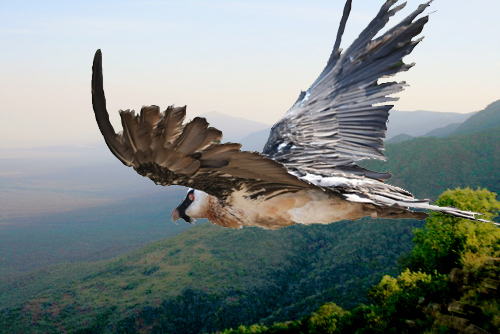
In the earliest days of my safari guiding, hardly 30 years old, I irritated more than one client by insisting that we needed time to visit Simon Ndege. “To see a bird?!” was the universal exclaim. But once they did, their hearts never stopped racing.
Simon moved around a lot. He lived in old houses abandoned by missions in the middle of the Great Frontier, or he assumed a mud hut some affluent tribesman built. He was very shy and spoke so softly you wondered if there was a voice in there at all.
I’d crowd my clients about twenty yards from his hut, he’d disappear inside for what seemed like an incredibly long time, and then out he came with some magnificent raptor on his arm. His favorites were peregrines in the days the bird was very threatened, but mine was the gargantuan martial eagle. How he even kept it on his arm was beyond me.
And then, he’d fly the bird for us. Binoculars focused, the pigeon released, the raptor took off creating a wind storm around our heads. Once you synced onto the incredible soaring flight it was amazing! And then, when the dive to the kill came, it was absolutely unbelievable. Peregrines plunged down at 250 miles per hour!
I know that not a lot of my clients had the binoc skills to watch this, but then they would put the binocs down, squint and still get the rush watching the dot in the air fall like meteorite! Then, dinner over, Simon uttered one of his multitude of different whistles and the bird returned to his arm like a pterodactyl in a James Cameron movie.
Simon let us come because he was so poor. Finally a number of us, whom I’m sure he never knew, managed to direct a few yet respectable Saudi princes to him, and for a few years he earned some good money. A pair of Simon’s desert raptors sold for $25,000 in the early 1980s.
But Simon wasn’t interested in selling birds. He wanted to make them free. A number of organizations kept Simon alive and happy, as he moved shyly through life among his grand and awesome birds.
When asked for a bio that could top a blog a woman friend now writes for him, this was all he had to say:
“I was born and raised in Kenya and have looked after raptors ever since I was a small boy. I’ve been rehabilitating and conserving large African eagles including Martial eagles and Crowned eagles, as well as falcons and hawks, for the last 16 years for the Peregrine Fund and the National Museums of Kenya. I work wherever the birds take me.”
Simon’s latest project was “Mutt,” a Lammergeyer, one of the most beautiful and endangered raptors in Africa, also known as the Bearded Vulture. In a rare account of his work, the attachment perhaps obsession that this extraordinary man has for raptors spills all over the narrative. But in between the sad facts of the failure in reintroducing Mutt is revealed in much greater amplitude than I was ever privileged to know the story of a very special and dedicated lover of birds.
I have edited the original blog, which you can read here.
**********************
the Lammergeyer Release
account by Simon Thomsett
transcribed by Sheryl Bottner
I was asked by a friend about the outcome of the Hell’s Gate Bearded Vulture re-introduction project. There is no way I could answer what took up years of my time in a few brief sentences so I thought I could write this blog. In a nutshell, five Bearded Vultures (Lammergeyers) were rescued from Ethiopia in 2001-2002. The project had multi-NGO backing including support from the Peregrine Fund finance, Kenya Wildlife Service and the Ethiopian Wildlife and Conservation Organisation. The project was partly successful with two of five released birds surviving in the wild for years.
Our intention was to take 15 birds, some put aside for captive breeding, some for immediate release. We could easily have filled that quota with the abundance of Ethiopian nests, but logistically it provided tough to do. Although I had great support from volunteers and colleagues and for two years it was easy to see the famous “Lammergeyer’s of Hell’s Gate,” active persecution of the released birds and proliferation of industries within Hell’s Gate together with a burgeoning human population compromised the continuation of the plan. Two of the five birds were lost.
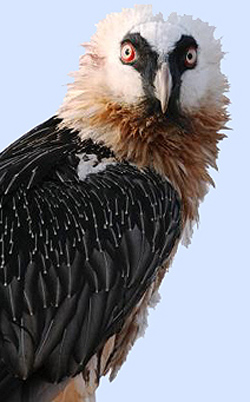
The final destination for Mutt the Lammergeyer was not as we had planned. I hoped that she would be free and find a mate in the Nguruman mountains on the Kenya and Tanzania border.
In February 2009 Laila Bahaa-el-din and I delivered Mutt to Mark Jenkins at Ol Donyo Laro, below the Nguruman Mountains on the Shompole plains near the Kenyan/Tanzanian border. Mark built a shed on a mountain ridge so that Mutt could establish herself and get “homed in” to the location. Despite the cage she was feather perfect but she was unfit for the wild, so I decided to rig up an outside flight arrangement that allowed her to fly some 90m. For this I needed Matusa my old assistant who came out of retirement to help. Matusa, I hoped, would be able to put Mutt out each day and return her in the evening to the shed, lest leopards eat her.
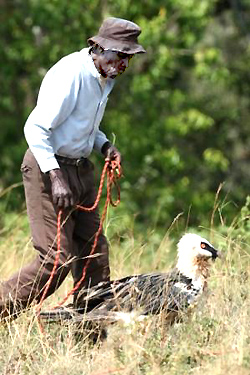
Finally we were ready to release Mutt and I drove back to the Jenkins’ ranch. This is some of the softest volcanic ash on earth. The wind-screen wipers struggled to keep dust out of our view. The air intake filter needed to be removed and cleaned every few kilometers. The drought was terrible at the time, exasperated by an invasion of livestock many times over that which the land could possibly sustain. Dead cattle and wildlife littered the road. Significantly not one was eaten by vultures or hyenas.
We met Mark Jenkins and after a grateful shower, fine meal and good night’s rest we continued the next day to drive the one hour up the mountain to Mutt’s domain. Matusa, well into his seventies, excitedly told me of the elephants that smashed trees outside of his banda the previous night. He recalled similar nights, many years ago near Machakos with a mournful shake of his head and click of his tongue. There haven’t been elephants there for the past 40 years.
The trouble with Lammergeyers (Bearded Vultures) is that they do not train up like other more conventional raptors. They find it difficult to land on a glove for example. They never get keen or hungry enough to consider flying to receive their food on a lure or glove like a hawk. While there is a negative side to training Mutt it would greatly have helped her overcome her physical weakness and allowed her to understand that she could habitually feed at a certain location. I just didn’t have the time to train her. The best we could do was to give her a long climbing rope to fly up and down from perch to perch. Since her earlier failed release I noted that she had spent much of her time leaping about and fracturing the tips of her flight feathers. She was obviously keen to go.
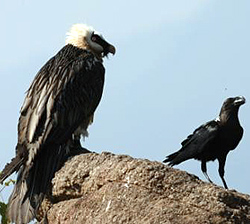 Mutt and two wild White-necked Ravens had become good buddies and I hoped they would help lead Mutt in search of food when she was free. I heard from the rangers that one raven got too cheeky and while stealing food was grabbed by Mutt. Some respect was now afforded to Mutt. Alarmingly the rangers and I had not seen more than three vultures from Mutt’s shed for the past nine months! Mark Jenkins had seen a few groups but he too recognized their serious decline. This was something inconceivable only a few years ago when dozens would be expected each day.
Mutt and two wild White-necked Ravens had become good buddies and I hoped they would help lead Mutt in search of food when she was free. I heard from the rangers that one raven got too cheeky and while stealing food was grabbed by Mutt. Some respect was now afforded to Mutt. Alarmingly the rangers and I had not seen more than three vultures from Mutt’s shed for the past nine months! Mark Jenkins had seen a few groups but he too recognized their serious decline. This was something inconceivable only a few years ago when dozens would be expected each day.
On October 7 we took Mutt’s jesses off. Matusa walked her to her favorite rock. Mutt sat there as though nothing had changed. I wanted no dramatic release. She should leave at her own chosen speed and not be hurried into it. The hours ticked by. The magnitude of the event was long past and we all turned our attention away. I lowered the camera. Then the wind stirred. She lifted off and sailed past the perch and over the valley.
We ran for binoculars and telescopes to see her traverse distant mountain ridges with the grace of a veteran. She vanished out of sight heading towards Tanzania. I turned on the radio receiver to hear its edifying silence. Later just before dusk the radio signal was faint, then strong. She had moved back into range. Somewhere within 30 kilometers she spent the night.
* * *
(From Jim: A successful release of a rehabilitated raptor begins with its first flight, but it never immediately flies away. Often for weeks it returns to the “hack” site where it first launched, where the falconer provides the normal meals the bird ate during captivity. As the bird regains its skills and develops its muscle tone, it will begin to hunt on its own, finally abandoning the hack site for good. Mutt never returned to the hack site, so Simon had to track her down.)
* * *
Mutt the Lammergeyer flew into a border zone where security is not so good. The next five days were some of the toughest I have had for many years. I scrambled, slid, abseiled and climbed in search of an elusive “blip” on a radio receiver. I was scared because if she was killed or disappeared out of radio contact I would have the death of a very rare animal on my conscience. The responsibility of it was sickening especially so as others would be sure to take a dim view of failure. In hands-on wildlife management critics are ever ready to oppose, no matter what the outcome. It was not good to worry about people’s opinions but as we searched with an ever increasing risk of finding her dead, I kept reinventing what I was going to have to report. In every respect this was the best chance Mutt would have, with the huge resources of Ol Donyo Laro supporting her. If she failed here she would have no hope anywhere else.
I exhausted three ranger patrols, which would have made me chuffed had I not been highly alarmed and in dread of finding her dead. Frustratingly Mutt proved yet again her total inability to return to the “hack” site for food. Instead she hid. Sometimes she must have flown out of one canyon into another, hugging the forested contours and never venturing out into visual range.
From a distance the Nguruman mountains look like rolling hills cloaked in forest with patches of cliffs and open grassland glades. From afar these look ideal and it is possible to find elephant paths that allow easy walking. You can walk the entire length of these mountains in glorious wooded avenues stamped asunder by millennia of elephants and buffalos. To picture the untrodden slopes in which Mutt was so unkind as to spend the night, think of taking a few dollops of mashed potatoes and arranging them in a neat line like Alpine mountains. Then with the back of the fork go berserk scraping the lower sides with furrows and ridges. Then pour thick gravy all over it so that you cannot see these wicked furrows and you have made the section of mountains in which Mutt decided to hide. It looks smooth and forested from the outside, but in fact it is deeply scared beneath with a myriad ridges. It is impossible to get a good fix on a radio signal because radio waves bounce or get cloaked depending upon the landscape.
Larle, a ranger who had helped me with the previous failed release, was inexhaustible and stayed with me for two days. Like me he was unarmed and did not carry a flak jacket, provisions, radio, heavy army boots etc., as did our original accompanying ranger force. We left them far behind as we moved mostly on all fours through terrible terrain.
The second night I woken with deep pain in the back and was unable to sleep until dawn. The day before, while negotiating a rocky slope in thickets I had slipped badly and hurt my stomach and back with the stiff backpack which had a thick kidney belt. The next morning I urinated some blood and decided to take it easy and stayed in camp. Thankfully things settled down. All I got that day from Mutt was a steady and reassuring signal coming from the same sort of area far across the valleys. The next day we went early with a fresh team who surged ahead and left me behind. They had no idea where they were going and soon came back. Cautious about my health I plodded along warning them that they had no idea what was in store for them. They needed to reserve their energy.
The next 10 hours saw us sliding and crashing up and down vertical banks, sometimes on ropes. The rangers would pause every hour to shake their heads in wonder. Surely none had seen these parts of the mountain. Mutt’s signal was wandering. She was flying. We went lower down the mountain descending hundreds of meters mostly on our backs and finally appeared at a large spring. The water was cold, very pure and much appreciated. The spring fed a small riverine line of tall trees and beyond it was the lowland hot acacia woodlands. The hill here was called Milima moto (meaning hot hill), and it lived up to it.
The rangers, feeling as though they had all survived an awesome experience all expressed a resolution that no matter what, we would continue on and find Mutt no matter how far she had gone. They were prepared to walk a week or more and have rations dropped on them from the sky. Still feeling beat from ailing kidneys, my comradery with my new fraternity faltered at this suggestion and I sincerely hoped that I could borrow a plane instead.
In line with her radio signal we saw a Crowned Eagle fly out over the hot lowlands and descend fast. I thought this odd because Crowned Eagles are restricted to the high forested slopes from which we had come. The radio suddenly went quiet, an ominous sign so we immediately pursued the signal now over this flat landscape. We trudged on towards a huge salt lake sweating profusely in the stifling heat. I tried the radio receiver and changed course to the left. It was so faint a signal and she sounded a very long distance away. Maybe she was covering ground fast. Then appearing before us were a few giraffe looking down, and there on the ground was Mutt. She had been beaten to the ground by the Crowned Eagle.
In the next few weeks I organized a new home for her at the Honorable Mutula Kilonzo’s residence near Machakos. Mutt has had more than enough opportunities for freedom and has demonstrated an inability to return to the place of release. She never ate and spent her freedom sulking, frightened and hidden. Even with the full support of Ol Donyo Laro and their formidable team of rangers we recognized that another release attempt would be fatal. I was disappointed in the lack of other wild Lammergeyers, as these hills were a previously known habitat for this species. The future of Mutt must now include captive breeding.
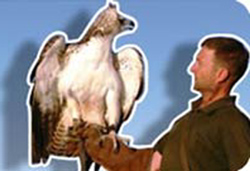
To be honest I dread the responsibility of re-opening the Bearded Vulture re-introduction project, as it will entail considerable physical effort and fiscal resources. Neither of which I have these days! The lessons I learnt nearly a decade ago were not so much the difficulty in achieving a re-introduction, but the insurmountable problems encountered in modern day conservation bureaucracy. Personally now, I have a few priorities to straighten out securing a place to work and live, before I can focus attention on Mutt, again.
Hi Jim:
Great story.
-Ric Zarwell